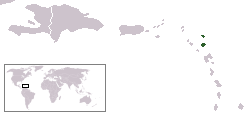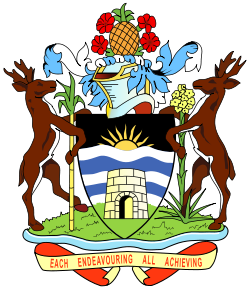
Antigua and Barbuda is a sovereign island country in the West Indies. It lies at the conjuncture of the Caribbean Sea and the Atlantic Ocean in the Leeward Islands part of the Lesser Antilles.

The flag of Kiribati is red in the upper half with a gold frigatebird flying over a gold rising sun (otintaai), and the lower half is blue with three horizontal wavy white stripes to represent the ocean and the three archipelagoes. The 17 rays of the sun represent the 16 Gilbert Islands and Banaba.

The coat of arms of the Philippines features the eight-rayed sun of the Philippines with each ray representing the eight provinces which were placed under martial law by Governor-General Ramón Blanco Sr. during the Philippine Revolution, and the three five-pointed stars representing the three major island groups of Luzon, the Visayas, and Mindanao.

The Leeward Islands are a group of islands situated where the northeastern Caribbean Sea meets the western Atlantic Ocean. Starting with the Virgin Islands east of Puerto Rico, they extend southeast to Guadeloupe and its dependencies. In English, the term Leeward Islands refers to the northern islands of the Lesser Antilles chain. The more southerly part of this chain, starting with Dominica, is called the Windward Islands. Dominica was originally considered a part of the Leeward Islands, but was transferred from the British Leeward Islands to the British Windward Islands in 1940.

The following is an alphabetical list of topics related to the nation of Antigua and Barbuda.

The national flag of Antigua and Barbuda was adopted on 27 February 1967 to mark the achievement of self-government. A competition to design the flag was held in which more than 600 local people entered. The winning design was put forth by nationally well-known artist and sculptor Sir Reginald Samuel.

The flag of Belize was adopted on 21 September 1981, the day Belize became independent. It consists of the coat of arms of Belize on a blue field with red stripes at the top and bottom.

The coat of arms of Anguilla is the heraldic device consisting of a shield charged with three orange dolphins leaping over the sea. Adopted in 1990, it has been the coat of arms of Anguilla since that year. The escutcheon is featured on the flag of the territory.

The coat of arms of the Bahamas contains a shield with the national symbols as its focal point.

The coat of arms of the British Virgin Islands consists of a green escutcheon (shield) charged with a woman in a white dress and gold-coloured sandals, holding a lit golden oil lamp and surrounded by eleven other golden lamps. Adopted shortly after the islands became a Crown colony, it has been the coat of arms of the British Virgin Islands since 1960. The escutcheon dates from the early 19th century and is featured on the flag of the territory. The woman and the lamps represent Saint Ursula and her companions, the namesake of the islands.

The coat of arms of Montserrat consists of an escutcheon (shield) charged with a woman in a green dress holding a golden harp and a black cross. In use since at least 1909, it has been the official coat of arms of the Caribbean island of Montserrat since the island became a British Crown colony in 1962. The escutcheon is featured on the flag of the territory.

The coat of arms of Dominica was adopted on July 21, 1961. It consists of a shield with two guardian sisserou parrots bracing the shield atop of which is a lion passant. The quarters of the shield depict a canoe, a banana tree, a palm and a frog of the native species known as the mountain chicken. Below the shield is the national motto: Apres Bondie C'est La Ter.

The flag of Sint Maarten consists of a white triangle situated at the hoist charged with the constituent country's coat of arms, along with two horizontal bands of red and blue. Adopted in 1985 shortly after the territory was granted a coat of arms, it has been the flag of Sint Maarten since 13 June of that year. Since the dissolution of the Netherlands Antilles on 10 October 2010, it has been the sole flag used in the constituent country.

The coat of arms of Saint Kitts and Nevis was adopted in 1983 and possesses the motto "Country Above Self". The previous coat of arms, adopted in 1967 by the colony of Saint Christopher-Nevis-Anguilla, was nearly identical, except for coloration and the motto "Unity in Trinity".

The British Leeward Islands was a British colony from 1671 to 1958, consisting of the English overseas possessions in the Leeward Islands. It ceased to exist from 1816 to 1833, during which time it was split into two separate colonies. It was dissolved in 1958 after the separation of the British Virgin Islands, and the remaining islands became parts of the West Indies Federation.

The flag of the British Leeward Islands was the flag of the Federal Colony of the Leeward Islands. It was a Blue Ensign with a badge. The colonies under the Federal Colony had their own badges from 1909. The Governor-in-chief of the Leeward Islands used a Union Flag defaced with the coat of arms.

The badge of the British Leeward Islands was adopted in the 1870s.

The following outline is provided as an overview of and introduction to Antigua and Barbuda:
Antigua was discovered by Christopher Columbus, in 1493, and was named after the church of Santa Maria la Antigua in Seville. It was first settled in 1632. By the Treaty of Breda in 1667 it became a British Possession.


















